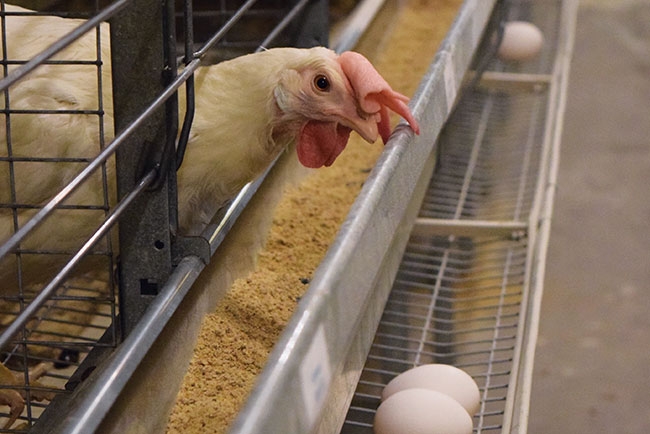
LRIC Update: Early maturation in laying hens
By Lilian Schaer
Features HealthResearchers compare three lines of layers.
 “If a bird isn’t fully mature, it will be at risk of calcium deficiencies, egg quality issues and potential injury.” PHOTO CREDIT: Charlene Hanlon
“If a bird isn’t fully mature, it will be at risk of calcium deficiencies, egg quality issues and potential injury.” PHOTO CREDIT: Charlene HanlonGrégoy Bédécarrats has spent the better part of a decade studying poultry and how they respond to light. It was during this research that he noticed something unusual: modern laying hens were maturing early and starting to produce eggs while they were still in the pullet barn, and without photo-stimulation, the use artificial light to trigger maturation.
“When pullets enter lay too early, they aren’t necessarily fit, because when they start laying, they stop growing,” Bédécarrats explains. “So, if a bird isn’t fully mature, it will be at risk of calcium deficiencies, egg quality issues and potential injury.”
Intensive genetic selection over the last 50 years has resulted in significant egg production advances, including reducing the age at which birds start laying, shortening the time it takes for each egg to form and considerably lengthening the birds’ laying life spans.
Modern lines of layers are now expected to produce good quality eggs for at least 70 weeks and potentially for up to 100 weeks.
“Something inside the bird tells it that it’s ready to lay, regardless of breed or age, so we wanted to find out what triggers the laying,” says PhD student Charlene Hanlon who worked on this research with Bédécarrats.
Researchers compared three lines of White Leghorn hens: the Lohmann LSL lite commercial strain (highly selected strain), the Smoky Joe strain which is similar to a 1960s bird (non-selected strain) and the White Leghorn heritage line (mid-selection strain from 2003).
Birds were raised until 100 weeks of age. Growth, production and general health were monitored and compared, and blood and tissues were collected to help identify possible causes of any observed differences between the lines.
“The non-selected birds had the same body weight window – 1.431 to 1.494 kilograms – as the highly selected, but the latter reached that weight level faster,” Bédécarrats says.
According to Hanlon, modern layers grow too fast, specifically their body composition or fat-lean ratio. This means management of body weight and growth of the pullets is absolutely key.
“It’s important to monitor the body weight of pullets as they grow and get closer to the time of transfer to the adult barn to make sure they don’t exceed the target weight,” she says. “If you let Lohmans eat at will, they will exceed the weight, get too heavy and start laying before going into the adult barn.”
They also found a link between hormonal changes and longer laying cycles. In modern layers, the hormonal profile of estrodial goes up and down repeatedly, and since estradiol helps absorb dietary calcium and helps put it in storage in bones, matching dietary calcium levels with estradiol profiles would be the best practice so producers could supplement rations with calcium to give birds when they need it most.
“We can directly link the hormone to the laying period; it’s the cornerstone hormone that will help the hen manage nutrients for egg production,” she explains.
Every 10 weeks of extra laying time reduces CO2 emissions by one gram per bird compared to a replacement flock. Keeping hens longer also means producers can reach their quota targets with fewer pullets, resulting in lower feed and other input costs.
However, one of the practical limitations is hens aren’t synchronized – hormonal patterns and feeding patterns are specific to the individual bird, not the flock. That said, work looking into precision feeding at the individual bird level is underway in collaboration with Martin Zuidhof at University of Alberta.
“It’s individual management, the equivalent of personalized medicine – this will be the technology of the future,” says Bédécarrats.
This research was supported by Egg Farmers of Ontario, Ontario Agri-Food Alliance, the University of Guelph’s Food from Thought program and a Natural Sciences and Engineering Research Council discovery grant.
Lilian Schaer is a freelance writer and editor and communications specialist with Agri-Food Project Services Ltd. in Guelph, Ont.
Print this page